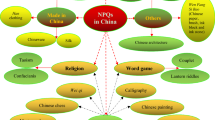Abstract
A comparative study was undertaken to determine the difference in quality, antioxidant activity, and mineral content of northern and southern Indian tea varieties. The results showed that the antioxidant activity, theaflavin and thearubigin content, color particle size and total soluble solids influence the tea leaf and tea dust. Assam leaf showed higher values for all the physico-chemical properties followed by Darjeeling leaf. In addition, the mineral composition of the tea infusion was also influenced. The preparation method, including the amounts of tea and water used, infusion time was shown to be a major determinant of the component concentrations of tea beverages as consumed. An illustration of the variation introduced by these varieties of tea is provided by comparing solids, caffeine, minerals and antioxidant activity of black teas available locally.
Similar content being viewed by others
References
Borse BB, Jagan Mohan Rao L, Nagalakshmi S, Krishnamurthy N (2002) Fingerprint of black teas from India: identification of the regio-specific characteristics. Food Chem 79(4):419–424
Cloughley JB, Ellis RT, Pelnlington S, Humphrey P (1982) Volatile constituents of some Central Africa Black-tea clones. J Agric and Food Chem 80:842–845
Dreosti IE, Wargovich MJ, Yang CS (1997) Inhibition of carcinogenesis by tea: the evidence from experimental studies. CRC Crit Rev Food Sci Nutr 37:761–770
Ferrara L, Montesanoa D, Senatore A (2001) The distribution of minerals and flavonoids in the tea plant. II Farmaco 56:397–401
Gallahera RN, Gallaherb K, Marshalla AJ, Marshallc AC (2006) Mineral analysis of ten types of commercially available tea. J Food Comp Anal 19:S53–S57
Gulati A, Ravindranath SD (1996) Seasonal variation in quality of Kangra tea (Camellia sinensis) in Himachal Pradesh. J Sci Food Agric 71:231–236
Gulati A, Tamang MB, Ravindranath SD (1999) Clonal variation in quality related biochemicals in Kangra tea (Camellia sinensis). J Plant Crops 27:175–178
Howard GE (1978) The volatile constituents of tea. Food Chem 4:79–106
Jayaprakasha GK, Singh RP, Sakariah KK (2001) Antioxidant activity of grape seed (Vitis vinifera) extracts on peroxidation models in vitro. Food Chem 73:285–290
Narin I, Colak H, Turkoglu O, Soylak M, Dogan M (2004) Heavy metals in black tea samples produced in Turkey. Bull Environ Contam Toxicol 72:844–849
Oktay M, Culcin I, Kufrevioglu OI (2003) Determination of in vitro antioxidant activity of fennel (Foeniculum vulgare) seed extracts. Lebensmittel-Wissenschaft and -Technologie 36:263–271
Oyaizu M (1986) Studies on the product of browning reaction prepared from glucose amine. Jpn J Nutr 44:307–315
Pedro LF, Martin MJ, Pablos F, Gonzalez AG (2001) Differentiation of tea (Camellia sinensis) varieties and their geographical origin according to their metal content. J Agri Food Chem 49:4775–4779
Peterson J, Dwyer P, Jacques W, Rand R, Prior K, Chui K (2004) Tea variety and brewing techniques influence flavonoid content of black tea. J Food Comp Anal 17(3–4):397–405
Pura Naik J, Nagalakshmi S (1997) Determination of caffeine in tea products by an improved high-performance liquid chromatography method. J Agri Food Chem 45:3973–3975
Ramaswamy V (1995) An instrument for determining the free flow bulk density of black tea. Plant Chron 90:323–325
Singleton VL, Rossi JA (1965) Colorimetry of total polyphenolic with phosphomolybdic—phosphotungstic acid reagents. Am J Ecol Vitic 16:144–158
Subramaniam B (1995) Tea in India. Publication and information directorate. CSIR, and Wiley Eastern Ltd, New Delhi
Takeo T, Mahanta PK (1983) Comparison of black tea aromas of orthodox and CTC tea and of black tea made from different varieties. J Sci Food Agric 34:307–310
Tijburg LBM, Mattern T, Folts JD, Weisgerber UM, Katan MB (1997) Tea flavonoides and cardiovascular diseases: a review. CRC Crit Rev Food Sci Nutr 37:771–785
Ullah MR (1972) A simplified spectrophotometric method for measuring theaflavins and thearubigins in black tea liquors. Curr Sci 41:422–423
Ullah MR (1985) Aroma constituents of Assam and China hybrid teas and their manifestation during tea processing. Two Bud 32:60–62
Ullah MR (1986) A rapid procedure for estimating theaflavins and thearubigins of black tea. Two Bud 33:46–48
Wiseman SA, Balentine DA, Frei B (1997) Antioxidants in tea CRC. Crit Rev Food Sci Nutr 37:705–718
Xie M, von Bohlen A, Klockenkamper R, Jian X (1998) Multielement analysis of Chinese tea by total reflection X-ray fluorescence. Z Lebensm Unters Forsch A 207:31–38
Yamanishi T, Kobayashi AH, Uchida A, Mori S, Ohsawa X, Sasakura S (1968) Flavour of black tea: comparison of various types of black tea. Agric Biol Chem 32:379–386
Yang CS, Wang ZY (1993) Tea and cancer. J Nat Cancer Inst 85:1038–1049
Yang J, Liao K, Kim EJ, Yurkow CS, Yang CS (1998) Inhibition of growth and induction of apoptosis in human cancer cell lines by tea polyphenols. Carcinogenesis 19:611–616
Yasmeen F, Aleem R, Anwar J (2000) Determination of iron and manganese in tea samples by flame atomic absorption spectroscopy. J Chem Soc Pak 22:94–97
Acknowledgements
The authors are thankful to the Director, CSIR—Central Food Technological Research Institute, Mysore for his constant help, encouragement and the facilities provided for carrying out the experiments. The authors also thank the Head, Plantation Products, Spices and Flavour Technology (SFS) for providing facilities and encouragement.
Author information
Authors and Affiliations
Corresponding author
Rights and permissions
About this article
Cite this article
Khanum, H., Faiza, S., Sulochanamma, G. et al. Quality, antioxidant activity and composition of Indian black teas. J Food Sci Technol 54, 1266–1272 (2017). https://doi.org/10.1007/s13197-017-2506-y
Revised:
Accepted:
Published:
Issue Date:
DOI: https://doi.org/10.1007/s13197-017-2506-y




